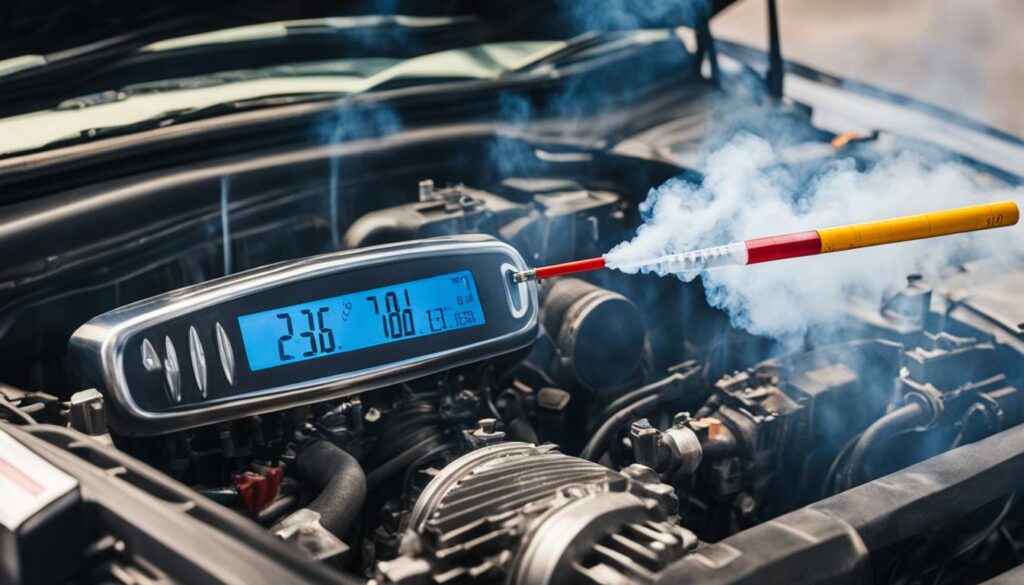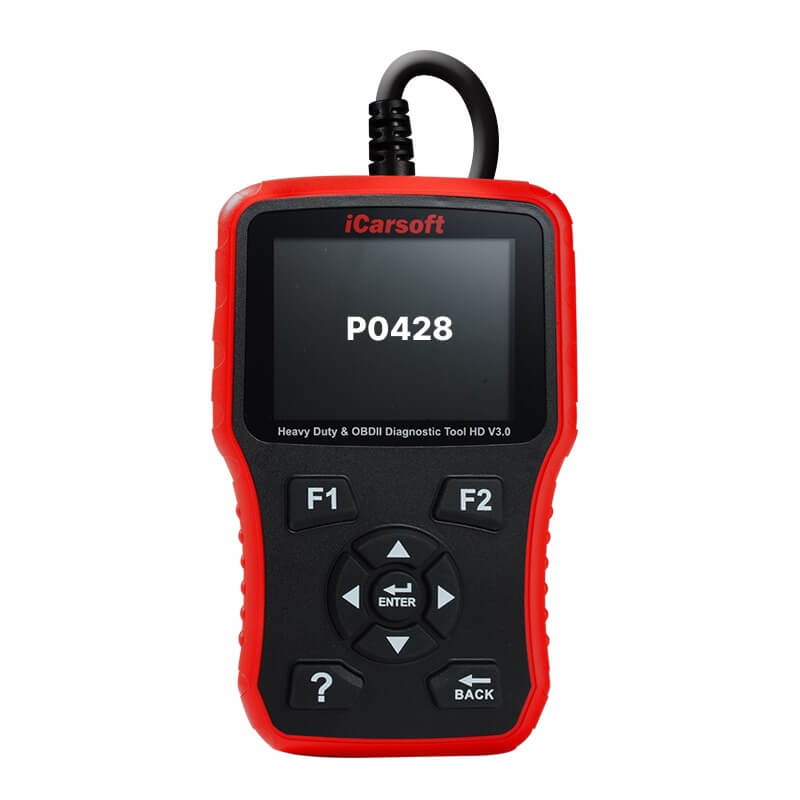P0428 – Catalyst Temperature Sensor High
POSTED IN pcodes
The P0428 code refers to the catalyst temperature sensor being high in bank one. This code is stored when the powertrain control module (PCM) receives a high-resolution signal from the optical sensor that counts pulses on the sensor disk in the injection pump. This signal is important for the PCM’s fuel control and timing abilities. The code indicates that the three-way catalytic converter is not operating as efficiently as intended. Possible causes include a malfunctioning temperature sensor, shorted or open harness, poor electrical connection, or a faulty PCM. Symptoms can range from a simple Check Engine light to engine stalling or refusal to start. Diagnosis involves using an OBD-II scanner, checking the oxygen sensor and wiring, inspecting the catalytic converter and other engine components, and potentially examining the PCM. Common mistakes when diagnosing the code include replacing the catalytic converter without addressing the underlying issue. This code is serious due to its potential to cause expensive damage, and repairs may involve addressing emissions problems, replacing faulty parts, or reprogramming the PCM.
Key Takeaways:
- The P0428 code refers to a high temperature reading from the catalyst temperature sensor in bank one.
- Possible causes of the code include a malfunctioning temperature sensor, shorted or open harness, poor electrical connection, or a faulty PCM.
- Symptoms can range from a simple Check Engine light to engine stalling or refusal to start.
- Diagnosis involves using an OBD-II scanner, checking the oxygen sensor and wiring, inspecting the catalytic converter and other engine components, and potentially examining the PCM.
- Common mistakes when diagnosing the code include replacing the catalytic converter without addressing the underlying issue.
What is the P0428 code and its meaning?
The P0428 code is an automotive diagnostic trouble code that refers to a high temperature reading from the catalyst temperature sensor in bank one. This sensor plays a crucial role in monitoring the temperature of the catalytic converter, which is responsible for reducing harmful emissions from the exhaust gases.
When the engine is running, the powertrain control module (PCM) receives a high-resolution signal from an optical sensor. This sensor counts pulses on a disk within the injection pump to measure the rotational speed accurately. The high-resolution signal is vital for the PCM’s fuel control and timing abilities, ensuring optimal engine performance and efficiency.
The P0428 code indicates that the three-way catalytic converter is not operating as efficiently as intended by the manufacturer.
The catalytic converter is designed to convert harmful pollutants in the exhaust gases into less harmful substances through a series of chemical reactions. However, when the catalyst temperature sensor detects a high temperature reading, it signifies a potential problem with the catalytic converter’s efficiency. This issue can lead to increased emissions, reduced fuel economy, and diminished engine performance.
Buy tested tuning file for Adblue / EGR / DPF / Adblue off now!
Manufacturers design catalytic converters to meet specific emissions standards and optimize engine performance. When the P0428 code is present, it indicates a deviation from the manufacturer’s intent, highlighting the need for further diagnosis and repairs.
Role of the Catalyst Temperature Sensor
The catalyst temperature sensor plays a crucial role in regulating the catalytic converter’s temperature. By accurately measuring the converter’s temperature, the sensor provides important feedback to the PCM, allowing it to adjust fuel injection and ignition timing accordingly.
Monitoring the catalyst temperature helps optimize the converter’s efficiency and ensures proper emissions control. The PCM uses the data from the sensor to make real-time adjustments, contributing to improved engine performance, reduced emissions, and compliance with environmental regulations.
The image above illustrates the importance of the catalyst temperature sensor in the overall engine management system.
Common causes of the P0428 code
When diagnosing the P0428 code, there are several common causes that mechanics should consider. These causes contribute to the disruption in the proper functioning of the catalyst temperature sensor, ultimately resulting in the code being stored. The following are the most frequent culprits:
- A malfunctioning temperature sensor: A faulty temperature sensor can provide inaccurate readings, triggering the P0428 code.
- A shorted or open harness connected to the sensor: Electrical issues with the sensor’s harness, such as a short circuit or open connection, can interfere with its operation.
- A poor electrical connection: Loose, corroded, or damaged electrical connections can disrupt the signal transmission between the temperature sensor and the PCM, leading to the code being stored.
- A faulty PCM: A malfunctioning powertrain control module (PCM) can fail to interpret the sensor’s data correctly, resulting in an erroneous P0428 code.
These common causes highlight the importance of a thorough diagnostic process to identify the specific issue and initiate the appropriate repairs.
Symptoms of the P0428 code
The P0428 code can manifest through various symptoms, with the severity depending on the specific circumstances. In some cases, the only noticeable symptom may be the illumination of the Check Engine light, alerting the driver to a potential issue.
However, more severe symptoms can occur with the P0428 code. Engine stalling or refusal to start are possible indications of a malfunction. Drivability issues may also arise, such as engine hesitation, poor engine performance, and hissing noises during acceleration. If left untreated, these symptoms can worsen over time and affect the overall performance of the vehicle.
Common Symptoms of the P0428 code:
- Check Engine light: Illumination of the Check Engine light is a common symptom associated with P0428. This warning light serves as an early indication of a potential problem in the vehicle’s system.
- Engine stalling: The engine may suddenly shut off or stall while driving or idling. This symptom can be concerning and inconvenient, affecting the vehicle’s drivability and safety.
- Refusal to start: The engine may not start at all or may exhibit difficulties starting. This symptom can be frustrating and may require multiple attempts to start the vehicle.
- Catalytic converter performance: The catalytic converter may not function efficiently, leading to decreased fuel economy and increased emissions. This symptom can result in poor overall performance and the need for more frequent visits to the gas station.
- Drivability issues: The vehicle may exhibit various drivability issues, including rough idling, reduced power, and difficulty maintaining speed. These symptoms can compromise the overall driving experience and safety.
- Engine hesitation: The engine may hesitate or exhibit a delay in response to throttle input. This symptom can affect acceleration and make the vehicle feel sluggish.
- Poor engine performance: The overall performance of the engine may be negatively impacted, resulting in reduced power, increased fuel consumption, and decreased responsiveness. This symptom can affect the driving experience and may require immediate attention.
If any of these symptoms are experienced, it is important to seek professional assistance to diagnose and address the underlying issue causing the P0428 code.

Diagnosing the P0428 code
Diagnosing the P0428 code involves a series of steps to identify the underlying issue. Here’s a step-by-step guide to diagnosing the P0428 code:
- Use an OBD-II scanner to review all stored problem codes.
- Check the oxygen sensor and its wiring for any faults or damage. This sensor plays a crucial role in monitoring the exhaust gases and providing data to the engine control module.
- Inspect the catalytic converter for any signs of damage or malfunction. A faulty catalytic converter can lead to inefficient emissions control.
- Examine other engine components that may have been affected by the high temperature reading, such as the exhaust system, fuel system, and ignition system.
- If no clear source of the code is found, it may be necessary to inspect the powertrain control module (PCM) itself. However, this step is rare as most cases can be resolved by addressing the aforementioned components.
By following these diagnostic steps, you can pinpoint the specific component or system that is causing the P0428 code. This will help you determine the appropriate course of action for repairs.
Example Diagnostic Steps:
1. Connect an OBD-II scanner to the vehicle’s diagnostic port.
2. Retrieve and record all stored trouble codes.
3. Inspect the oxygen sensor and its wiring for any visible damage or loose connections.
4. Conduct a visual inspection of the catalytic converter for signs of physical damage or restricted flow.
5. Use a multimeter to check the continuity and resistance of the oxygen sensor and wiring.
6. Perform a smoke test to detect any leaks in the exhaust system.
7. Inspect the PCM for any signs of water damage or corrosion.
Keep in mind that proper diagnosis of the P0428 code may require advanced tools and technical expertise. If you’re unsure about the diagnostic process or lack the necessary equipment, it’s recommended to seek professional assistance from a qualified mechanic.
| Component | Potential Issues |
|---|---|
| Oxygen Sensor | Malfunction, wiring fault |
| Catalytic Converter | Damage, restricted flow |
| PCM | Faulty or damaged |
| Exhaust System | Leaks, damaged components |
| Fuel System | Malfunction, improper fuel/air mixture |
| Ignition System | Faulty spark plugs, ignition coils |
Remember, accurate diagnosis is crucial to resolving the P0428 code effectively. By following these diagnostic steps and consulting with a professional when needed, you can identify and address the underlying issues, ensuring optimal engine performance and emissions control.
Common mistakes when diagnosing the P0428 code
When dealing with the P0428 code, it is crucial to avoid common mistakes during the diagnosis process. Unfortunately, many mechanics make these errors, leading to ineffective repairs and unnecessary expenses for the vehicle owner.
Lack of Thorough Research
One of the most common mistakes made when diagnosing the P0428 code is failing to conduct thorough research on the underlying cause of the problem. Some mechanics may quickly assume that the catalytic converter needs replacement based solely on the owner’s report, without investigating further. This can result in unnecessary costs and parts replacements, as the true source of the issue may lie elsewhere in the system.
Not Using OBD-II Scanner
Another mistake is neglecting to use an OBD-II scanner to check for other issues that may be contributing to the P0428 code. The scanner provides valuable information about the vehicle’s systems and can help identify additional problem codes or issues that require attention. By skipping this step, mechanics may miss vital clues that could lead to a more accurate diagnosis and cost-effective repair.
Assuming Without Addressing Underlying Issue
Assuming that the catalytic converter needs replacement without addressing the underlying issue is a common error made when facing the P0428 code. While a faulty converter can trigger the code, it is essential to identify the root cause before proceeding with any repairs. Failure to address the underlying problem can result in repeated code occurrences and continued poor performance.
To avoid these common mistakes, it is essential for mechanics to conduct thorough research, utilize an OBD-II scanner, and address the underlying issue rather than simply replacing the catalytic converter. By taking these steps, accurate diagnoses can be made, leading to effective repairs and satisfied vehicle owners.

Severity and Potential Repairs for the P0428 Code
The P0428 code can vary in severity, but it should always be taken seriously due to its potential to cause expensive damage. While some cases may not exhibit noticeable symptoms, a faulty catalytic converter can lead to a range of issues and increased emissions. Addressing the P0428 code may require repairs that target emissions problems, the replacement of faulty parts such as the temperature sensor or catalytic converter, or reprogramming the PCM.
When the P0428 code is present, it indicates that the catalyst temperature sensor in bank one is reading high. Ignoring this code can lead to greater damage and poor engine performance, impacting both the functionality and efficiency of the vehicle. Resolving the issue promptly is crucial to prevent further problems and potential catalytic converter failure.
Repairs for the P0428 code often involve diagnosing and addressing emissions problems that contribute to the code being triggered. This can include replacing faulty components such as the temperature sensor or catalytic converter, as well as ensuring proper electrical connections and harness integrity. In some cases, reprogramming the PCM may be necessary to correct any underlying issues that contribute to the high temperature reading.
It is essential to consult a professional automotive technician when dealing with the P0428 code. They have the expertise and specialized tools to accurately diagnose the problem and recommend the most appropriate repairs. Attempting DIY repairs without proper knowledge and experience can lead to further complications and potentially costlier repairs in the long run.
Addressing the P0428 code promptly and thoroughly can help restore the catalytic converter’s function, improve engine performance, and reduce emissions. Regular maintenance and inspections are also crucial in identifying and addressing any potential issues before they escalate into more severe problems.
Conclusion
In conclusion, the P0428 code indicates a high temperature reading from the catalyst temperature sensor in bank one. This code is an important indication of potential issues with the catalytic converter and can lead to serious damage and compromised engine performance if not addressed promptly.
Diagnosing and repairing the P0428 code requires accurate assessment and expertise. It is highly recommended to seek professional assistance for the diagnosis and repair process. Automotive professionals have the necessary tools, knowledge, and experience to identify the underlying cause of the code and perform the appropriate repairs to restore the vehicle’s functionality.
In some cases, professional assistance may not be readily available, or alternative solutions may be sought. One such solution is the permanent removal of the P0428 code through the upload of the ECU file to an online portal. However, it is essential to note that this solution may not address the root cause of the issue and may only provide a temporary fix.
Given the complexity of the P0428 code and its potential impact on the vehicle’s performance, it is crucial to prioritize professional assistance for accurate diagnosis and repair. Seeking the help of a qualified automotive technician will ensure a thorough assessment, appropriate repairs, and the long-term reliability of the vehicle.
FAQ
What is the P0428 code and its meaning?
The P0428 code refers to a high temperature reading from the catalyst temperature sensor in bank one. It indicates that the three-way catalytic converter is not operating as efficiently as intended. The code is stored when the powertrain control module (PCM) receives a high-resolution signal from the optical sensor that counts pulses on the sensor disk in the injection pump. This signal is crucial for the PCM’s fuel control and timing abilities.
What are the common causes of the P0428 code?
Common causes of the P0428 code include a malfunctioning temperature sensor, a shorted or open harness connected to the sensor, a poor electrical connection, or a faulty PCM.
What are the symptoms of the P0428 code?
Symptoms of the P0428 code can vary. They range from a simple illumination of the Check Engine light to engine stalling or refusal to start. Other symptoms include engine hesitation, hissing noises during acceleration, poor engine performance, and increased emissions.
How is the P0428 code diagnosed?
Diagnosing the P0428 code involves using an OBD-II scanner to review stored problem codes, checking the oxygen sensor and its wiring, inspecting the catalytic converter for damage, and examining other engine components that may have been affected. In rare cases, the PCM may need to be inspected.
What are the common mistakes when diagnosing the P0428 code?
Common mistakes when diagnosing the P0428 code include simply replacing the catalytic converter without addressing the underlying cause, not using an OBD-II scanner to check for other issues, and assuming the catalytic converter needs replacement without thoroughly researching the problem.
How severe is the P0428 code and what repairs are needed?
The severity of the P0428 code can vary, but it should be taken seriously due to its potential to cause expensive damage. Repairs may involve addressing emissions problems, replacing faulty parts such as the temperature sensor or catalytic converter, or reprogramming the PCM.


